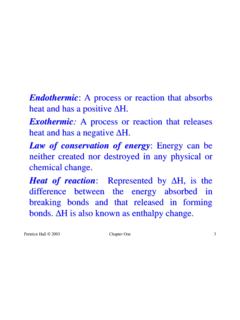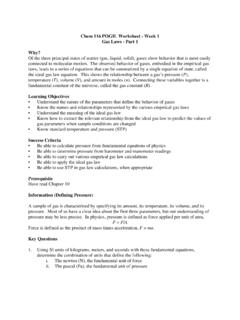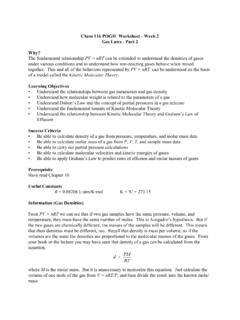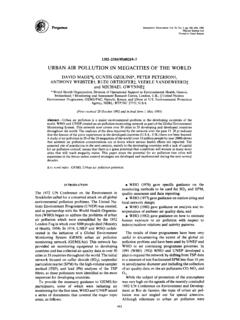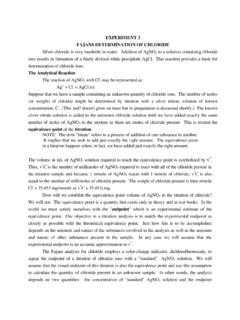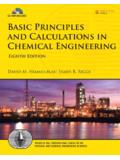Transcription of Chapter 15 Practice Questions
1 Chapter 15. MULTIPLE CHOICE. Choose the one alternative that best completes the statement or answers the question. 1) The value of Keq for the equilibrium 1). H2 (g) + I2 (g) 2 HI (g). is 794 at 25 C. What is the value of Keq for the equilibrium below? 1/2 H2 (g) + 1/2 I2 (g) HI (g). A) 1588 B) C) 28 D) 397 E) 2) The value of Keq for the equilibrium 2). H2 (g) + I2 (g) 2 HI (g). is 794 at 25 C. At this temperature, what is the value of Keq for the equilibrium below? HI (g) 1/2 H2 (g) + 1/2 I2 (g). A) B) 28 C) D) 397 E) 1588.
2 3) The value of Keq for the equilibrium 3). H2 (g) + I2 (g) 2 HI (g). is at 427 C. What is the value of Keq for the equilibrium below? HI (g) 1/2 H2 (g) + 1/2 I2 (g). A) 27. B) C) 103. D) E) 10-4. 1. 4) Consider the following chemical reaction: 4). H2 (g) + I2 (g) 2HI (g). At equilibrium in a particular experiment, the concentrations of H2, I2 , and HI were M, M, and M, respectively. The value of Keq for this reaction is _____. A) 61 B) 10-3 C) 23 D) 111 E) 5) A reaction vessel is charged with hydrogen iodide, which partially decomposes to molecular 5).
3 Hydrogen and iodine: 2HI (g) H2(g) + I2 (g). When the system comes to equilibrium at 425 C, PHI = atm, and PH2 = PI2. = atm. The value of Kp at this temperature is _____. A) 10-2. B) 10-2. C) Kp cannot be calculated for this gas reaction when the volume of the reaction vessel is not given. D) 10-2. E) 6) Acetic acid is a weak acid that dissociates into the acetate ion and a proton in aqueous solution: 6). HC2 H3O2 (aq) C2 H3 O2 - (aq) + H+ (aq). At equilibrium at 25 C a M solution of acetic acid has the following concentrations: [HC2 H3 O2] = M, [C2 H3 O2- ] = 10-3 M, and [H+ ] = 10-3 M.
4 The equilibrium constant, Keq, for the ionization of acetic acid at 25 C is _____. A) 104. B) 10-5. C) 10-7. D) E) 106. 2. 7) At elevated temperatures, molecular hydrogen and molecular bromine react to partially form 7). hydrogen bromide: H2 (g) + Br2 (g) 2 HBr (g). A mixture of mol of H2 and mol of Br2 is combined in a reaction vessel with a volume of L. At equilibrium at 700 K, there are mol of H2 present. At equilibrium , there are _____ mol of Br2 present in the reaction vessel. A) B) C) D) E) 8) Dinitrogentetraoxide partially decomposes according to the following equilibrium : 8).
5 N2O4 (g) 2NO2 (g). A flask is charged with mol of N2 O4 . At equilibrium at 373 K, mol of N2 O4. remains. Keq for this reaction is _____. A) 10-4 B) 13 C) D) E) 9) At 200 C, the equilibrium constant (Kp) for the reaction below is 103 . 9). 2NO (g) N2 (g) + O2 (g). A closed vessel is charged with atm of NO. At equilibrium , the partial pressure of O2 is _____ atm. A) B) 10-2. C) 294. D) E) 10) At 22 C, Kp = for the equilibrium : 10). NH4 HS (s) NH3 (g) + H2 S (g). A sample of solid NH4 HS is placed in a closed vessel and allowed to equilibrate.
6 Calculate the equilibrium partial pressure (atm) of ammonia, assuming that some solid NH4 HS remains. A) B) C) D) E) 10-3. 3. 11) In the coal-gasification process, carbon monoxide is converted to carbon dioxide via the following 11). reaction: CO (g) + H2 O (g) CO2 (g) + H2 (g). In an experiment, mol of CO and mol of H2O were placed in a reaction vessel. At equilibrium , there were mol of CO remaining. Keq at the temperature of the experiment is _____. A) B) C) D) E) 12) A sealed L flask is charged with mol of I2 and mol of Br2.
7 An equilibrium reaction 12). ensues: I2 (g) + Br2 (g) 2 IBr (g). When the container contents achieve equilibrium , the flask contains mol of IBr. The value of Keq is _____. A) B) 110 C) 11 D) E) 13) The equilibrium constant (Kp) for the interconversion of PCl5 and PCl3 is : 13). PCl5 (g) PCl3 (g) + Cl2 (g). A vessel is charged with PCl5, giving an initial pressure of atm. At equilibrium , the partial pressure of PCl3 is _____ atm. A) B) C) D) E) 14) Kp = at 721 K for the reaction 14). 2HI (g) H2 (g) + I2 (g). In a particular experiment, the partial pressures of H2 and I2 at equilibrium are and atm, respectively.
8 The partial pressure of HI is _____ atm. A) B) C) D) E) 15) At equilibrium , _____. 15). A) all chemical reactions have ceased B) the rate constants of the forward and reverse reactions are equal C) the rates of the forward and reverse reactions are equal D) the value of the equilibrium constant is 1. E) the limiting reagent has been consumed 4. 16) What role did Karl Bosch play in development of the Haber-Bosch process? 16). A) Haber was working in his lab with his instructor at the time he worked out the process. B) He originally isolated ammonia from camel dung and found a method for purifying it.
9 C) He developed the equipment necessary for industrial production of ammonia. D) He was the German industrialist who financed the research done by Haber. E) He discovered the reaction conditions necessary for formation of ammonia. 17) In what year was Fritz Haber awarded the Nobel Prize in chemistry for his development of a 17). process for synthesizing ammonia directly from nitrogen and hydrogen? A) 1954 B) 1912 C) 1933 D) 1900 E) 1918. 18) Which one of the following is true concerning the Haber process? 18). A) It is another way of stating LeChatelier's principle.
10 B) It is an industrial synthesis of sodium chloride that was discovered by Karl Haber. C) It is a process for the synthesis of elemental chlorine. D) It is a process used for the synthesis of ammonia. E) It is a process used for shifting equilibrium positions to the right for more economical chemical synthesis of a variety of substances. 19) Which one of the following will change the value of an equilibrium constant? 19). A) adding other substances that do not react with any of the species involved in the equilibrium B) varying the initial concentrations of products C) changing temperature D) varying the initial concentrations of reactants E) changing the volume of the reaction vessel 20) The equilibrium -constant expression depends on the _____ of the reaction.
